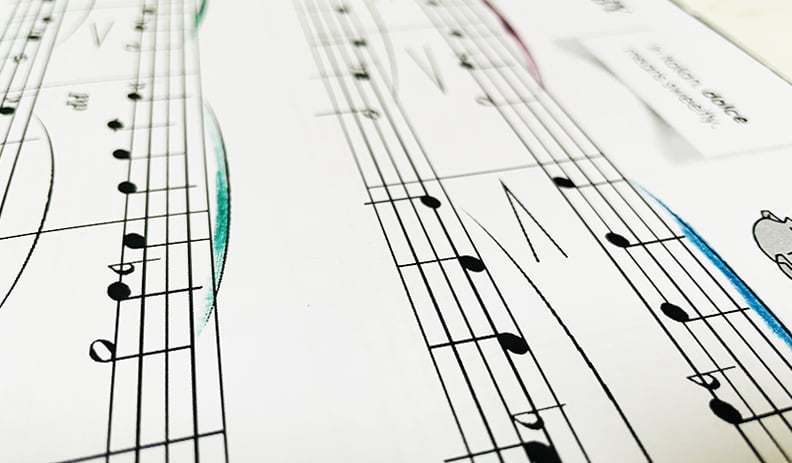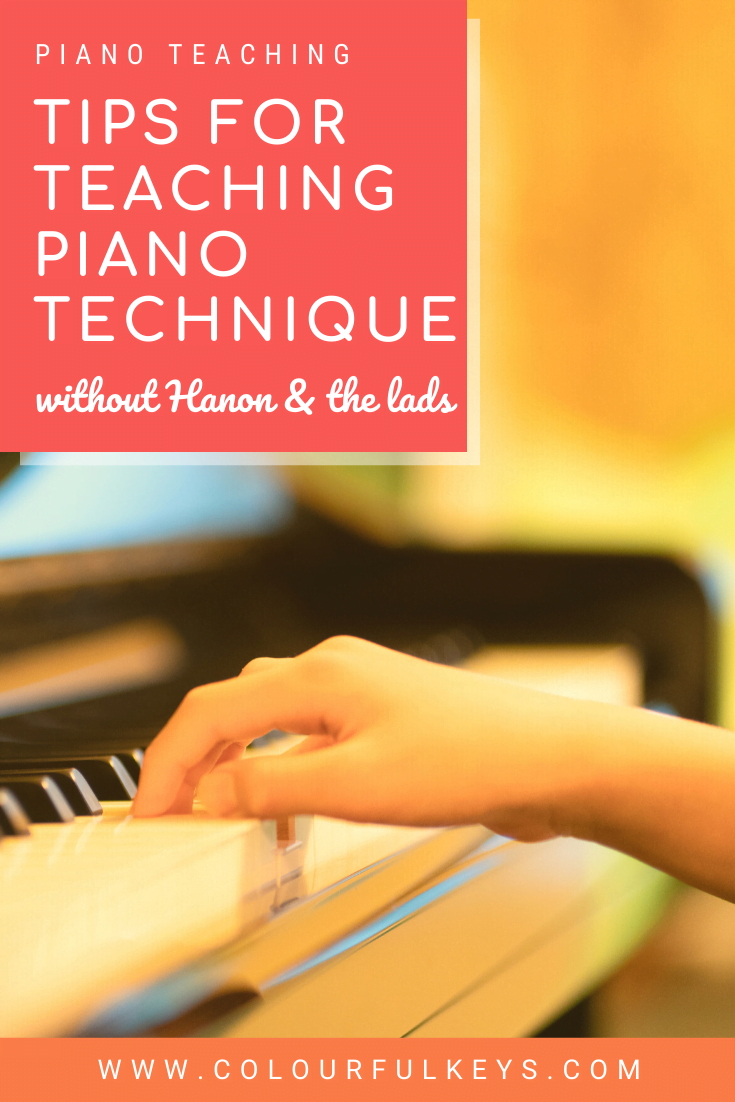The old paradigm for how to teach piano technique worked OK…ish.
I mean, it got many of us through our studies and towards teaching. But how many other students dropped off because of aches, pains, injuries, and inefficiencies?
In this article and podcast episode, we’ll look at how to teach technique effectively. And we won’t need any dry exercises.

⬆️ Listen to the podcast above or keep on reading, whichever fits your style. ↙️
Let’s clear one thing up before we go any further:
- Piano technique = how you move your body to play the piano
- Technical exercises = scales and other patterns like Czerny, Hanon and Dozen-a-Day
This article is about how to teach piano technique. There are many different and equally valid ways to approach that. Simply assigning technical exercises is not teaching technique.
You can absolutely apply some of these principles to Hanon later, if you really want to. But teaching technique, in my opinion, needs to include actual teaching (controversial, I know 🤪) not just assigning.
So bring the lads along if you wish, but just know that you don’t need them and they’re not the stars of the technique show.
You can learn more about teaching piano technique as well as other specific aspects of lessons by visiting my “Planning Piano Lessons” hub page.
Teach Piano Technique Using Physical Warmups
To set your students up for good posture, I recommend starting every lesson or practice session with a physical warmup routine.
Without good body posture, technical exercises are not going to help you get a good sound out of the piano. Playing the piano is a whole-body experience; isolating the fingers, wrists and forearms with specific exercises isn’t likely to engage other important aspects such as breathing.
Starting with a warmup routine can help your students develop great posture habits.
Warmup Routines
If you’re a member of Vibrant Music Teaching, you might like to try these One-Minute Warmups from the VMT Library.
(Not a member yet? Check out the awesome resources available in our membership program!)
Here’s another simple sequence you might use:
- Reach down towards the floor and roll back up slowly, stacking the spine.
- Swing the arms by your sides to feel their weight.
- Roll your shoulders and wrists.
- Sit on the front half of the piano bench and plant one foot and then the other.
- Lean forwards and backwards and find your centre-of-gravity point (midway between.)
- Lift your hands to touch the keys with a relaxed rounded handshape and then lift again to put them back in your lap.
Once you and your students get used to this, it will only take about a minute to complete and it could make the world of difference in their body awareness.
Deep Breathing
A few months ago I was listening to a fantastic episode of Beyond Measure with Christina Whitlock. She brought up the idea of associating the piano with relaxation through deep breaths.

I love this concept and have started to integrate it into my students’ warmup routines ever since. Just taking a few slow breaths before you begin can do wonders for your nervous system. 🙂
Yoga and Pilates
For those students who struggle with tension, move awkwardly or have hypermobility issues (me!), integrating some yoga and pilates exercises can also be helpful. The exact ones will depend on the issue they’re dealing with and they may need to reach out to a physiotherapist to design this routine for them.
Teach Piano Technique Using Specific Language
So now we get into the actual playing: the legato, staccato, arms and fingers of it all.
One of the things that frustrated me as a student was that I was never told exactly how to move. I didn’t analyse the mechanics involved in creating the various sounds until after I began teaching.
While musical descriptions and analogies are useful, I believe I would have done better with specific instructions.
Yes, these need to be connected to the music and the sound we create – but it’s useful for a young student to hear that the wrist needs to lift forward towards the fallboard at the ends of phrases, for example. It gives them something to grasp onto in their mind as they play and as they listen.
If you want the sequence of how I personally teach piano technique in the beginning stages of study, let me lay it out for you.
This is not meant to be a prescription. There are many ways to approach technique and you should absolutely use what works for you.
But I know it can be useful to hear the nitty gritty of how another teacher does it, so here we go! 🙂
Step 1: Teach Non-Legato on the Piano
I start my students with non-legato playing first, so they can learn to use their arm weight and don’t get rooted to the keys. I have found this leads to them playing with tremendous freedom and confident movements down the road.
I describe this movement to students as a gentle “bounce” which comes from their whole arm.
Step 2: Teach Legato on the Piano
Many regular readers will know I use the Piano Safari books more than any other and, in those books, legato is split into two kinds. Here is how I would describe these two types of legato:
- Tree Frog technique uses a light bounce of the wrist to get from key to key.
- Soaring Bird is a smooth technique facilitated by the wrist pivoting slightly to stay behind and supporting the playing finger.
For some students, I’ve found this to be a useful distinction. For others, tree frog seems very difficult and awkward for them at this stage, so we hop (pun intended) right on over to soaring bird.
Step 3: Teach Staccato on the Piano
I introduce staccato only after legato and non-legato are really solid. I describe this as being a movement of the whole arm straight up. (We deal with finger staccato much later.)
Step 4: Teach Slurs at the Piano
Next we start to talk about slur endings and practise lifting from the wrist to create the gradual tapering of the sound and softness we want. We practise this on two-note slurs initially, but soon apply it to all slur and phrase endings.
Step 5: Shaping Phrases
When many teachers talk about playing with expression, what they’re looking for are beautifully-shaped phrases.
Remember, I’m not against singing along, discussing the emotions behind a piece or listening to different recordings. But I also want to be able to describe to my students the mechanics of what is actually happening for those who find this helpful as a starting point.
So, for phrase-shaping or colour, I like to talk about “micro-dynamics” with my students. We’re not adding a full-on crescendo and diminuendo to every phrase; but we can act as if there’s an invisible mini crescendo-diminuendo set going towards and away from the most important note of the phrase.
I have my beginners shade this with colours on a few pieces, which really brings this to life.

Teach Piano Technique Using Imagination
Employing the imagination alongside the specifics is the other side of great technique teaching.
Most teachers have a tendency either towards the analytical mechanical descriptions or the flowery imaginative explanations. A great teacher will balance both sides of this coin.
Piano Technique Analogies
Analogies and imagined stories can be extremely useful tools when teaching piano technique.
The classic example is that playing staccato is like touching a hot stove and then immediately jumping away. (Not a big fan of this one, actually, because if I was reaching to touch a hot stove my body would be full of tension.)
I find these to be most effective when the teacher comes up with them through their work with students, so I won’t share my favourites here. 😉
Try experimenting with different similes and analogies and see what sticks with your students.
Improvisation & Composition
You don’t have to teach piano technique in a vacuum. Bringing your technique work into improvisation and composing projects is a fantastic way to make your lesson time more efficient and make the technique stuff more fun.
Win.
Win.
Try working on staccato and legato in an improvised duet. You can tell your student to match the articulation you use – or do the opposite!

If you’re doing a composing project, have your student test out all the different piano techniques they know before deciding which to notate. They could also write some helpful tips for the performer to help them use the technique effectively.
Teach Piano Technique Through Repertoire
As my students progress past the beginning stages, I like to draw their technique work directly from their repertoire.
There are so many beautiful pieces to explore and students are much more likely to grow as musicians and be motivated if they’re learning music which they really want to play.
Repertoire Roughage
With almost any new piece, it’s good practice to isolate the interesting part of the piece and ask students to practise this part as a musical exercise of its own.
They can do this section (or an extended version if needed) at the start of every practice session. They will learn so much more about the value of efficient technique when they apply it right away to a piece of music.
Rote Pieces
At the beginner to intermediate level, I love to use rote pieces to work on technique with my students.
When they’re not reading the music, I find that their brains tend to be freed up to focus on posture and movement. This allows them to practise playing with freedom and expression which they carry over into reading work, too.
Piano Safari supplements are great for this if you’re not using the full method.
Etudes
We’re back with Hanon and the lads.
Etudes do have their place in most studios, too. Personally, I use specific technical studies for particularly ambitious intermediate students who need to learn control and detail.
You know, those students who are always in a rush.
I also use some compilations like this one for advanced students who need shorter pieces to go alongside their long-term projects.
What are some ways that you teach piano technique?
I’d love to hear your thoughts on teaching great technique in the comments below. 🙂

Hi
I would like to appreciate you for your kind attention and for sending this helpful and effective article.
I am an adult piano learner and have had piano lessons for about 3 years. The word “technique” was very ambigious for me and I didnt have a clear idea about what exactly a technique is. Your article was very helpful.
I am also deeply interested in music processing in mind and brain and as a linguists I have been doing research on the comparison of these two cognitive systems.